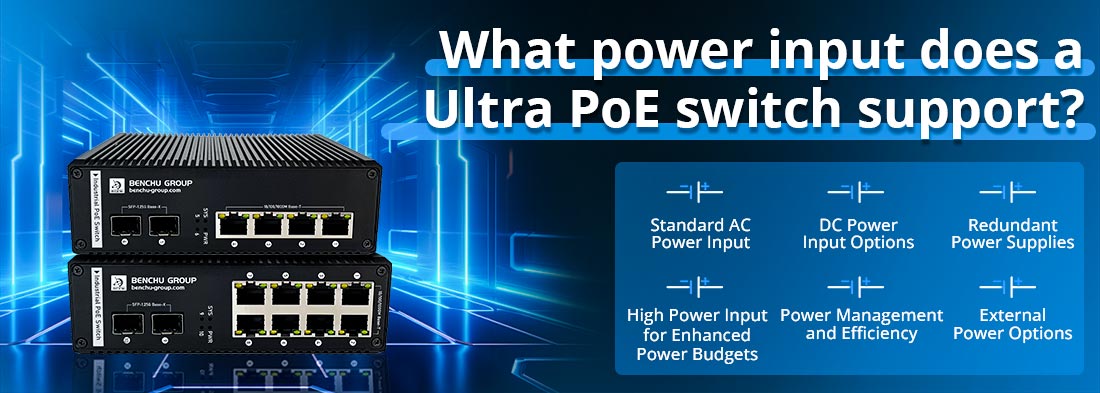
A entrada de energia para um switch Ultra PoE pode variar dependendo do modelo e design do switch. No entanto, os switches Ultra PoE são projetados para lidar com demandas de energia mais altas do que os switches PoE padrão, o que afeta o tipo de entrada de energia de que necessitam. Aqui está uma análise detalhada de quais opções de entrada de energia esses switches normalmente suportam:
1. Entrada de energia CA padrão
--- Mais Ultra Interruptores PoE são projetados para obter energia de uma fonte de alimentação CA (corrente alternada) padrão, geralmente variando entre 100-240 V CA. Esta ampla faixa de entrada os torna adequados para uso em diversas regiões e infraestruturas de energia sem a necessidade de conversores de tensão.
--- A unidade de fonte de alimentação interna (PSU) do switch converte esta entrada CA na energia CC (corrente contínua) necessária usada para operar o switch e fornecer PoE aos dispositivos conectados.
2. Opções de entrada de energia DC
--- Alguns switches Ultra PoE de alta capacidade ou de nível industrial podem suportar uma entrada direta de energia CC. Isto é especialmente útil em instalações onde a energia CC é preferida ou necessária, como em aplicações industriais, de transporte ou de energia renovável (por exemplo, sistemas de energia solar).
--- As faixas típicas de entrada CC podem variar amplamente, como 48 V CC ou 54 V CC, dependendo das necessidades de energia do switch e dos padrões PoE que ele suporta. Os switches Ultra PoE geralmente exigem tensões de entrada mais altas para fornecer maior potência aos dispositivos conectados.
3. Fontes de alimentação redundantes
--- Para garantir a confiabilidade, muitos switches Ultra PoE empresariais e industriais vêm equipados com fontes de alimentação duplas ou redundantes. Esses sistemas redundantes permitem que o switch mantenha a operação mesmo se uma fonte de energia falhar, proporcionando fornecimento contínuo de energia. As fontes redundantes podem suportar CA, CC ou uma combinação de ambos.
--- Entradas de energia redundantes são especialmente críticas em ambientes de alta disponibilidade, como data centers, infraestrutura crítica ou sistemas de vigilância.
4. Alta entrada de energia para orçamentos de energia aprimorados
Os switches Ultra PoE geralmente têm orçamentos gerais de energia mais altos para suportar dispositivos que exigem mais do que os níveis de energia PoE, PoE+ ou PoE++ típicos. A classificação de entrada de energia do switch está correlacionada com suas capacidades de saída. Por exemplo:
--- Um switch que suporta PoE++ (IEEE 802.3bt Tipo 4), que pode fornecer até 100 W por porta, pode exigir uma fonte de alimentação mais robusta, capaz de fornecer potência significativa para garantir que todas as portas possam fornecer sua saída máxima simultaneamente.
--- Para switches capazes de fornecer energia além de 100 W por porta, as fontes de alimentação de entrada podem ser projetadas para lidar com potências mais altas, como 500 W, 750 W ou até mais, dependendo do número total de portas PoE e de sua saída máxima.
5. Gerenciamento e eficiência de energia
Os switches Ultra PoE geralmente são construídos com sistemas eficientes de gerenciamento de energia que regulam e alocam energia de acordo com as necessidades do dispositivo conectado. A fonte de alimentação interna pode ajustar dinamicamente a distribuição de energia e pode incluir recursos como:
--- Capacidades de Power Ultraing, que amplificam a saída DC para garantir o fornecimento de alta potência aos dispositivos.
--- Priorização de energia, que aloca energia preferencialmente para portas críticas quando a demanda total de energia se aproxima do limite de fornecimento de entrada.
6. Opções de energia externa
Em alguns casos especializados, os switches Ultra PoE podem ser projetados para usar módulos de alimentação externos para flexibilidade adicional. Isso pode incluir a capacidade de se conectar a:
--- Sistemas de backup de bateria, para fonte de alimentação ininterrupta (UPS) em sistemas críticos.
--- Fontes de energia solar ou renovável, especialmente em locais remotos ou fora da rede, onde as fontes de energia tradicionais não estão disponíveis.
Visão geral dos requisitos de energia de entrada
| Recurso | Interruptor Ultra PoE |
| Entrada CA padrão | 100-240 Vca, 50/60 Hz |
| Entrada de energia CC | Normalmente 48 Vcc a 54 Vcc (varia de acordo com o modelo) |
| Fonte de alimentação redundante | Sim, muitas vezes com suporte para alta disponibilidade |
| Orçamento de energia | Fonte de alimentação de alta potência (por exemplo, 500 W, 750 W ou mais) |
| Opções de energia externa | Pode suportar bateria, UPS ou entrada solar |
Considerações para escolher a potência de entrada para um switch Ultra PoE
1. Requisitos de energia do dispositivo: certifique-se de que a energia de entrada possa suportar o orçamento máximo de energia necessário para todos os dispositivos PoE conectados.
2. Ambiente de instalação: Escolha a entrada CA ou CC com base na localização e na infraestrutura de energia. Áreas industriais ou remotas podem se beneficiar de opções de insumos DC ou renováveis.
3. Necessidades de confiabilidade: Para operações críticas, considere switches com entradas de energia duplas ou redundantes para manter a energia em caso de falha.
4. Orçamento total de energia: certifique-se de que a entrada de energia corresponda ao orçamento total de energia do switch para obter saída máxima simultânea em todas as portas.
Conclusão
Ultra Interruptores PoE são projetados para lidar com entradas de alta potência, normalmente suportando fontes de alimentação CA padrão e muitas vezes oferecendo opções de entrada CC para aplicações especializadas ou industriais. Eles podem vir com fontes de alimentação redundantes para maior confiabilidade e podem incluir opções de energia externa para cenários de implantação exclusivos. Esses recursos garantem que os switches Ultra PoE possam fornecer saídas de potência mais altas, alcance estendido e operação confiável em ambientes exigentes.